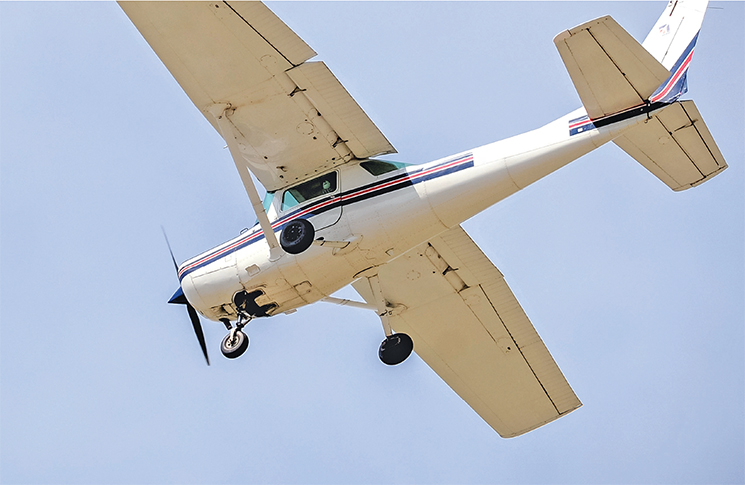An experienced airline transport pilot remembers 2 close calls early in his career that shaped his approach to safety.
Back in 2009 I was flying out of Tindal on a perfect dry season day. The company’s Cessna 210 was loaded to the brim with mail ready for the 11.5-hour duty, a 15-stop day.
It was a big day out but when you want to build up hours, days like these are a gift from heaven. They are long days, hard work, hot and demanding but fun, nevertheless.
I finally get to go flying and for once I’m not the one paying for the hours!
The challenge with days like these are the last few sectors. You’re tired, hungry, you’ve landed and taken off 12 times and the last 3 sectors are the long ones. I was joining the circuit on my 13th stop, at 1000-foot circuit height, from early left downwind, all checks complete, my gear is down, all looking good.
Start the base turn and descend. Turn final, quick final check at 500 feet. Suddenly, I glanced down and saw my shadow – or so I thought. After a second glance, I realised it couldn’t be my shadow, because of the position of the sun. I was a split second away from landing on top of a Cessna 172!
It was so close that I can’t remember much, other than applying full power as I start a go-around with a hard bank away from the unexpected intruder! I remember landing and having some strong words with the pilot of the other aircraft. He had no idea what had just happened and seemed oblivious to the fact that I almost landed on top of him.
The story told was: he only had an HF radio, his VHF was unserviceable and he was airborne for only 15 minutes, checking some fencing on his farm.
It was an experience that left me in shock. How could someone be flying around and not have a radio – or have a radio and be on the wrong frequency?
That brings me to another story, at Gove in the NT. Lining up for a 10-mile straight-in final on runway 13, I see a shape coming straight towards me. I bank hard left just as the shape was also banking left. The pilot, totally oblivious to my position, had taken off on the reciprocal runway 31 and was making a left-turn departure.
He couldn’t see me as the nose cowling was blocking his view. But he was also on the wrong CTAF frequency so didn’t even know I was there. It was a VFR Baron or a blurry twin that looked exactly like a Baron. He later got on the correct frequency and apologised after I explained what had just happened.
I was a split second away from landing on top of a Cessna 172!
Years later, I reflect on my experiences in the bush. I am now blessed to fly a jet with a fancy FMS, EGPWS, TCAS and other bells and whistles but I’m still reminded of those close calls.
Not only am I flying IFR, which is great, but I am also flying from the safety of a capital city CTA to middle-of-nowhere mine sites in class G, or to places like Alice Springs, Gove and Mackay where there isn’t always a tower active. It makes me a tad apprehensive to just trust my TCAS or what I hear on frequency. And sometimes silence makes me even more anxious.
I’d be the first to admit that I am probably a bit more trigger happy than most when making CTAF calls. However, I definitely do not want to relive those past experiences.
Lessons learnt
Complacency is the problem, for both farmer Joe and me. It is easy to allow complacency to creep in, to allow the aeroplane to fly a fully coupled RNP, disconnect the autopilot at the minimums and land. However, the problem is farmer Joe is still out there, checking his fences with his radio disconnected, another pilot is flying around with an incorrect CTAF frequency or, worst of all, their transponder is off and they are blind to ATC and my fancy TCAS.
Situations like these are rare but as pilots, we prepare for the worst and expect the best. The best lesson in these scenarios is to keep your head on a swivel and keep a sharp lookout, especially when it’s that last sector after a long day and all you can think about is shutting down and going home. 
Online extra
Don’t forget to check out the audio close calls. Hear the stories come to life.
Non-controlled operations
Non-controlled operations is one of the special topics on our Pilot safety hub. Refresh your knowledge.
Have you had a close call?
8 in 10 pilots say they learn best from other pilots and your narrow escape can be a valuable lesson.
We invite you to share your experience to help us improve aviation safety, whatever your role.
Find out more and share your close call here.
Disclaimer
Close calls are contributed by readers like you. They are someone’s account of a real-life experience. We publish close calls so others can learn positive lessons from their stories, and to stimulate discussion. We do our best to verify the information but cannot guarantee it is free of mistakes or errors.





Comments are closed.